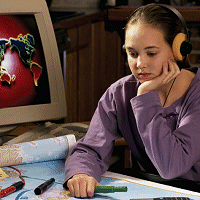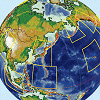Here, There, and Everywhere
##AUTHORSPLIT##<--->
Whether out in the field or in the classroom, students are using mappingtechnologies to develop an awareness of where data comes from and what it means.
 ALTHOUGH DIGITAL MAPPING DEVICES are growing in use in the society at large—from sports enthusiasts and census takers, to cars and boats—the technologies are just starting to gain traction in K-12. Advocates of digital mapping in the field and classroom say that it encourages skills like critical thinking and decision-making, and can serve as an excellent way for students to learn where data comes from and how to collect it, along with learning about their local area’s history, geography, topography, animaland plant populations, and much more.
ALTHOUGH DIGITAL MAPPING DEVICES are growing in use in the society at large—from sports enthusiasts and census takers, to cars and boats—the technologies are just starting to gain traction in K-12. Advocates of digital mapping in the field and classroom say that it encourages skills like critical thinking and decision-making, and can serve as an excellent way for students to learn where data comes from and how to collect it, along with learning about their local area’s history, geography, topography, animaland plant populations, and much more.
Digital mapping for educational purposes begins in the field with a global positioning system, which is used to receive information from several dozen GPS satellites orbiting the earth. Students can use GPS devices to pinpoint various locations with remarkable accuracy. Recently, prices have dropped on GPS devices, making them much more affordable for schools. For example, a basic system from Garmin International that is common in K-12 use retails for around $100.
Back in the classroom, a “geographic information system” is used to collect the map points into a database for further manipulation. The information entered into the GIS can be collected in the field on a GPS device, or can come from elsewhere—the internet is a rich source of location-specific data. Students import that data to a GIS database and can create tables and maps, overlaying and comparing layers of information such as weather, land boundaries, historic locations, and scientific data.
Students used probes to gather data along a local river.When the data was loaded into a GIS system, it revealed spikesof high nutrients at one location on a given date. The studentstraced the cause back to a specific septic system failure,which was then repaired.
Along with growing public appreciation of the value of visual mapping, and drops in equipment and software prices, there’s another reason mapping technologies are gaining in popularity in education: The software has become much easier to use. Whereas GIS packages were once expensive and difficult to use, new software has recently appeared that is simple, designed for non-scientific users—including K-12 students—and best of all, often free or very inexpensive. “We’re trying to make sure that teachers don’t have huge technical issues to overcome,” says Mike Bridge, vice president of marketing and product management at PASCO (Paul A. Stokstad Co.) Scientific, which offers several tools that can be used for GPS and GIS purposes. “The usability bar is continuing to drop.”
According to professor Marsha Alibrandi, students worldwide are conducting original research in the field as part of GPS and GIS projects. Alibrandi works in social studies education in the Graduate School of Education and Allied Professions at Fairfield University in Connecticut. She is the author of the book GIS in the Classroom: Using Geographic Information Systems in Social Studies and Environmental Science.
As an example of one of the hundreds of projects Alibrandi has participated in, students used probes to gather data at specific points on a local river. The points were tied to a computerized map of their town and the surrounding area. When the collected data was then loaded into a GIS system, it revealed spikes of high nutrients at one location on a given date. The students traced the cause back to a specific septic system failure, which was then repaired.
MAPPING RESOURCES
Three ways to inexpensively incorporate GPSand GIS into the classroom. Global Learning and Observations to Benefit the Environment (GLOBE). A worldwide education project in whichschoolchildren share environmental research conducted using probes andGPS devices. It’s perhaps the largest program in which real geographicdata is collected by students for GIS purposes. According to the GLOBEwebsite, 36,000 GLOBE-trained teachers from 19,000 schools worldwidehave contributed 15 million measurements to the project.
Global Learning and Observations to Benefit the Environment (GLOBE). A worldwide education project in whichschoolchildren share environmental research conducted using probes andGPS devices. It’s perhaps the largest program in which real geographicdata is collected by students for GIS purposes. According to the GLOBEwebsite, 36,000 GLOBE-trained teachers from 19,000 schools worldwidehave contributed 15 million measurements to the project.
My World GIS. A geographic information system designed for use in middle school through college educational settings. The software program was developed by Northwestern University through a series of National Science Foundation (www.nsf.gov) grants. It comes with 50 or so data sets, including such options as world climates and presidential election data. My World costs $99 for a 10-seat license; you can download a free 45-day trial version for starters.
ArcExplorer Java Edition for Education. A free, downloadable Windows and Mac desktop client that allows basic mapping activities, from ESRI.
More Educational Uses
The most common use of mapping technology in education, according to Charlie Fitzpatrick, K-12 education manager at ESRI, a large GIS mapping software company, takes students and teachers outdoors, where they use GPS devices to gather information at various geographic points. They then return to the classroom, transfer the data to a GIS system, and work with it further.
“We work with lots of teachers who are going out with their GPS units doing the data gathering, whether it’s waterquality monitoring or [counting] squirrel nests in trees,” Fitzpatrick says. “They then bring their data back into the classroom and do the analysis.”
For social studies, GPS devices and GIS software can be used in combination, for example, to map cultural landscapes such as colonial stone walls, burial mounds, or potential archaeological sites. “A digital map can have an enormous number of ‘points’ associated with different phenomena,” Alibrandi says, “from soil pH to the location of a gemstone, a dinosaur bone, a microwave tower, or a cultural artifact.”
According to Fitzpatrick, putting together a GPS and GIS program needn’t be costly. “Teachers with very low-end GPS units can do pretty significant work out in the field,” he says,“then bring it in and manipulate it using free [GIS] software,”like ArcExplorer (see “Mapping Resources,” side bar) or evenMicrosoft Excel, which is commonlyfound on classroom computers. Fitzpatrick also notes thatGPS tools don’t have to be high-end to be useful in education.“Honestly, we find that most teachers are happy withthe very modest tools.”
The Value of Data Analysis
Whether gathering data themselves or simply importing it from another source before studying it, students develop an awareness of where data comes from and what it means, says PASCO’s Bridge. “With GIS, users make a map and look at it, using tools that…tempt students to say, ‘Okay, I want to zoom in now; I want to ask a question of the data.’”
One particular educational strength of GIS is that it is based around a learning cycle. “You have a topic that you want to explore, so you gather some data and you visualize that data,” Fitzpatrick explains. “You display it and you look at it in a different way, analyze it, classify it, query it. Then you come up with some kind of modified question about the data, which leads to a new tweak.”
That cycle continues as students try new combinations, find new answers, and in turn conceive of new questions—in short, practice their critical-thinking skills. Rather than asking students to memorize answers, GIS systems, according to Fitzpatrick, say to them, “‘Here’s data. What are the kinds of things you can glean from this?’ It entices them to explore.”
Linda L. Briggs is a freelance writer based in San Diego.